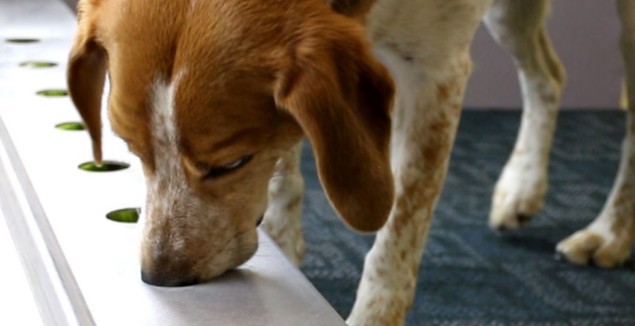
Dogs trained to sniff out early signs of cancer in human breath are probably detecting large molecules captured on aerosols rather than more volatile substances present as gases, say researchers in the US and Canada.
Joachim Pleil and colleagues at the US Environmental Protection Agency collaborated with cancer-screening company CancerDogs in Canada to identify the chemicals that distinguish samples classified by dogs as either positive or negative for cancer. While liquid chromatography mass spectrometry (LCMS) detected a suite of chemical features that shared a statistically significant correlation with the dogs’ diagnoses, gas chromatography mass spectrometry (GCMS) turned up no significant relationship. The result bodes well for potential preclinical screening techniques, as it is simpler to capture aerosols and other particles from breath than it is to sample the component gases (J. Breath Res. 10.1088/1752-7163/ab433a).
Spotting cancers early is key to successful treatment, but sometimes the disease can spread before clinically detectable symptoms begin to appear. Routine screening might one day identify such preclinical cases, and could be used to test members of high-risk groups – such as firefighters, who are exposed regularly to carcinogens – even if it proves unrealistic to screen the population at large.
Specially trained dogs have already been used for this purpose with some success, identifying signs of cancer in breath samples from apparently healthy human subjects. As dogs cannot explain their methods, however, we still do not know exactly how they arrive at their conclusions.
“The primary disadvantage of using dogs is that they can’t talk, so we don’t know what compounds they are cueing in on,” says Pleil. “Ultimately, if we want to figure out the biochemistry of cancer and convince ourselves that dogs are really finding preclinical biomarkers, then we need some serious laboratory investigations.”
For Pleil and colleagues, “serious laboratory investigations” meant subjecting breath samples collected on hospital-style face masks to analysis by LCMS and GCMS. The masks had been worn by firefighters enrolled in a cancer-screening trial run by CancerDogs, and subsequently had been unanimously but independently categorized by the four dogs involved in the trial as either “case” (meaning cancer) or “control” samples.
“What we want to find out is whether there are any specific compounds that light up as different between cases and controls, and try to figure out if they make any sense biochemically,” explains Pleil.
From the start, the researchers were not expecting to gain much insight from any gas-phase compounds identified using GCMS, since volatile molecules usually escape from the mask material before the dogs get near them. Their hunch was borne out when a statistical analysis of the 44 distinct chemical features detected in the samples failed to observe any significant correlation between the dogs’ classifications and the laboratory results.
The team’s analysis of larger, semi-volatile or non-volatile molecules detected by LCMS was more fruitful, however. This technique identified 345 distinct compounds, whose relative abundance varied according to whether they came from samples that had been classified as case or control during the canine trials. Even so, the explanatory power of the LCMS results was weak, suggesting that, when categorizing the samples, the dogs were sensitive to chemicals or chemical combinations not yet recognized by the instrumental analysis.
“We can’t speculate about what the dogs are really detecting, but our interpretation is that there is likely an overlap between the laboratory methods and canine olfaction,” says Pleil. “Keep in mind that instruments do not use the same analytical ‘senses’ as dogs. The dogs could be cueing on large reactive compounds that might not survive chromatography, or they could be detecting patterns that may not be the same in the instruments due to differences in sensitivity.”
To some extent, this uncertainty can be attributed simply to insufficient data. The researchers hope that this knowledge gap can be filled by increasing the number of samples tested and applying multiple analytical techniques. Extending the investigation to include chemical species not yet detected should strengthen the team’s predictive model.



